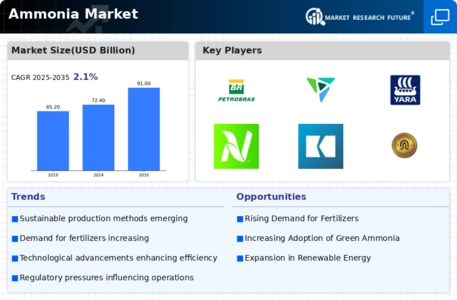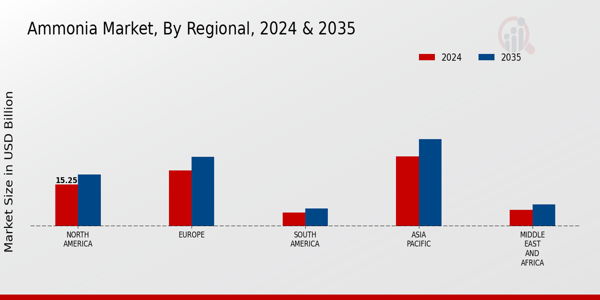Market Trends
Introduction
As we enter 2024, the ammonia market is about to be transformed by a confluence of macroeconomic factors. Green ammonia synthesis, for example, is reshaping the way we produce and consume. Regulations aimed at reducing carbon dioxide emissions are forcing the industry to adapt and innovate. And a shift in consumer behavior, in the form of an increased demand for sustainable farming practices, is also having an effect. These macroeconomic trends are strategically important for our shareholders, not only because they determine our competitive positioning, but also because they also serve to align our goals with broader economic and environmental objectives.
Top Trends
-
Green Ammonia Production
Those who invest in green energy are promoting a shift to green ammonia production. Yara International has, for example, launched projects to produce ammonia with wind and solar energy. By 2025 the company hopes to achieve zero carbon emissions. Estimates indicate that this trend will significantly reduce CO2 emissions. This trend will have an effect on business practices, which include increased investment in green technology and cooperation with companies that produce green energy. -
Decarbonization Initiatives
The stricter decarbonization policies of governments all over the world are influencing the ammonia production processes. The Green Deal of the European Union aims to reduce greenhouse gas emissions by at least 55 percent by 2030. In order to meet these requirements, CF Industries is using new, cleaner technology. The new regulations are reshaping the business strategies of the company. The focus is on CO2 capture and storage solutions. Future developments may include increased funding for research into low-carbon ammonia production. -
Ammonia as a Hydrogen Carrier
Ammonia is recognized more and more as a good hydrogen carrier, facilitating the transport and storage of hydrogen. As a leading company in the field of ammonia, BASF is already experimenting with its use in hydrogen supply chains. This could lead to a more tightly integrated hydrogen economy, with ammonia playing a key role. The practical consequences of this include the need for a suitable ammonia-hydrogen transport system. -
Increased Fertilizer Demand
Ammonia production is pushed by the growing demand for fertilizers, especially nitrogen fertilizers. According to industry figures, more than 80 per cent of ammonia is used in the fertilizer industry. The fertilizer companies are expanding their production capacities to meet the growing demand, especially in emerging markets. This will lead to higher investments in production and to a more efficient logistics system to ensure timely deliveries. -
Technological Advancements in Production
TECHNOLOGICAL INNOVATIONS IN AMMONIA PRODUCTION HAVE GREATLY INCREASED THE EFFICIENCY AND COST OF PRODUCTION. For example, OCI Nitrogen is investing in advanced catalytic processes to increase yield and reduce energy consumption. These innovations will reduce the carbon footprint of ammonia production. Artificial intelligence and machine learning can be used for process optimization. -
Regulatory Compliance and Safety Standards
The Ammonia market is shaped by stricter regulatory and safety standards. The companies are required to meet the new guidelines. The EPA has set stricter guidelines for the handling of ammonia. This trend requires increased investment in safety training and the improvement of the facilities, which will affect the operating costs. Those companies who adapt to the new regulations voluntarily will have an advantage over the others. -
Global Supply Chain Resilience
The COVID 19 pandemic exposed the fragility of the world's supply chains, and made businesses rethink their strategies. Like Koch Industries, for example, companies are diversifying their suppliers and investing in local production to increase their resilience. This trend will lead to a more localized production model and reduce reliance on the international supply chain. There will be greater cooperation between local producers. -
Sustainable Agricultural Practices
The application of ammonia is influenced by the tendency towards a more sustainable agriculture. Companies like Orica are developing products to optimize the use of ammonia and reduce the amount of waste and the impact on the environment. This development is expected to increase the yield of the crops while reducing the amount of fertilizer lost to the environment. And the use of digital tools for the management of agricultural resources could also be included in the development. -
Investment in Infrastructure Development
It is necessary to develop the ammonia industry in order to meet the growing demand for ammonia, especially in the developing countries. In some countries, such as India, the government is providing funds for the construction of storage and distribution facilities. This is likely to improve the supply and reduce the cost of logistics. Future developments will be based on public-private partnership schemes to accelerate the construction of such facilities. -
Collaboration and Partnerships
In the field of the economy, the collaboration of the different players is becoming a necessity for innovation and market expansion. Strategic alliances like those of a company like the one that is called Eurochem are being established to pool knowledge and resources, to strengthen their position in the market. In the field of ammonia, this trend is expected to lead to technological innovations in the production and use of ammonia. In the future, more and more joint ventures may be established to promote the improvement of efficiency and the pursuit of sustainable development.
Conclusion: Navigating the Ammonia Market Landscape
The ammonia market in 2024 is characterized by a highly competitive market structure and significant fragmentation. Several companies, both old and new, compete for market share. Regional trends are characterized by a growing emphasis on innovation and sustainability, which is reflected in the development of advanced capabilities such as artificial intelligence, automation and flexibility. The older companies are able to exploit their established networks and experience, while the new companies focus on sustainable practices and technological innovations to distinguish themselves from the competition. These advanced capabilities will be a critical success factor for market leadership in the future and will enable companies to respond quickly to changing demands and regulatory environments. Strategic investments in these areas are therefore required in order to maintain a competitive advantage and exploit emerging opportunities.















Leave a Comment